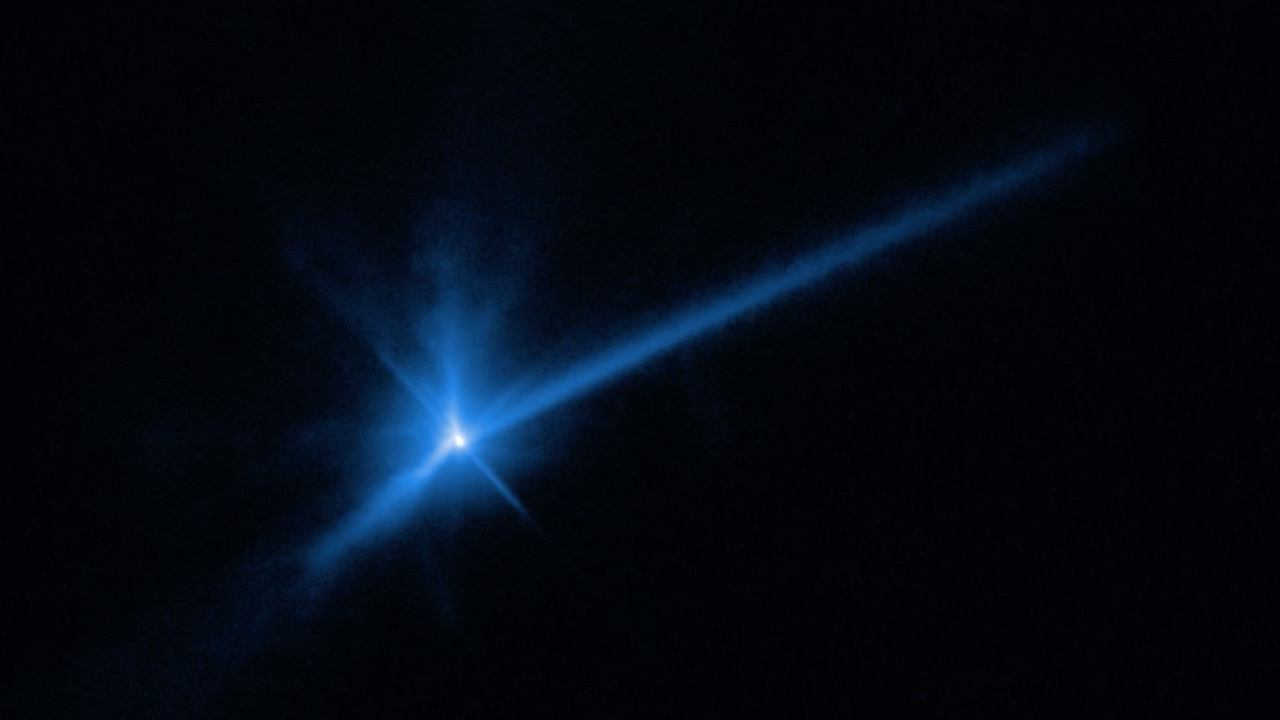
On Sept. 26, 2022, NASA's Double Asteroid Redirection Test (DART) spacecraft slammed into the asteroid Dimorphos at nearly 15,000 mph (24,000 kph).
DART's goal was to test our ability to defend Earth from a threatening rock by nudging it out of harm's way. The test was a brilliant success, and it also revealed how the battered asteroid came to be: Dimorphos didn't form on its own but rather as a ring of material flung off from its larger parent, Didymos.
To understand Dimorphos, we have to look to Didymos, because the two near-Earth asteroids create a binary system. Didymos is the larger of the two, at about half a mile (800 meters) across. Dimorphos, which is about 525 feet (160 m) wide, orbits Didymos in an almost perfectly circular retrograde orbit (meaning the motion of its orbit is opposite the direction of Didymos' spin) in just about 12 hours.
Related: NASA's DART asteroid crash: What scientists have learned about Dimorphos so far
Didymos itself is spinning rapidly — so rapidly, in fact, that it has bulged out into an ellipsoidal shape around its equator. This is the first clue as to the formation of Dimorphos, researchers explained in a paper published in January to the preprint database arXiv.
Asteroids tend to not lose angular momentum, meaning that once they get spun up, they usually stay that way. So Didymos probably began spinning long ago, perhaps as soon as it formed. To create that kind of rapid spin, the researchers turned to something known as the YORP effect.
YORP stands for Yarkovsky, O'Keefe, Radzievskii, and Paddack, the names of the scientists who made major contributions to our understanding of the phenomenon. The YORP effect is based on the fact that asteroids are not perfectly smooth or perfectly shaped; they have all sorts of strange bumps, wiggles and protrusions.
All these shapes reflect sunlight in different ways. One part of an asteroid may scatter sunlight back toward the sun, while another part may bounce light in a completely different direction. Though sunlight doesn't have mass, it does have momentum, and it's perfectly capable of pushing on objects, as solar sails have recently demonstrated.
Because of all the different interactions with sunlight, the YORP effect leads to an overall rotation of an asteroid. The effect is incredibly small, but asteroids themselves aren't very big either, and over the course of millions of years, the YORP effect can go from a gentle nudge to a massive spin.
How Dimorphos formed
In fact, the researchers propose that the YORP effect was so strong on the young Didymos that it triggered avalanches on the surface, which were then flung away from the parent asteroid due to the extreme angular momentum. That material then gathered in a ring surrounding Didymos. The researchers estimate that Didymos may have lost up to half its mass through this process.
Some of that material naturally calmed down a little and rained back down onto Didymos, but some stayed in orbit. There, the dust and ice particles stuck together through electrostatic attraction — the same force that keeps a rubbed balloon sticking to you.
Eventually, the ring of particles coalesced into a series of minimoons, which the researchers call "satellitesimals." These satellitesimals, each no bigger than a few meters across, then interacted and collided with one another. Sometimes, those collisions sent the satellitesimals back onto the surface of Didymos, and sometimes, those collisions sent them flying off into space.
But eventually, enough satellitesimals congealed together to form a proper satellite: Dimorphos.
The researchers explored several models of formation, going from ring to fully developed satellite. One possibility is that it took over a century for Dimorphos to form, which would lead to a slow-spinning, extremely lumpy satellite.
But if the formation of Dimorphos took less than a year, it should be spinning rapidly and have an oblate shape, just like its parent. The reason for this is that with every collision of one satellitesimal onto the ever-growing main body, it would add a bit of angular momentum, causing it to spin faster and faster.

Even though Didymos and Dimorphos are near-Earth asteroids, their small size and relative lack of shininess make them difficult to observe in detail. But with NASA's DART test, we were finally able to get close-up images of Dimorphos.
Those images reveal a surface of boulders loosely held together by the slim gravity of the small asteroid. Overall, Dimorphos looks like a top — much fatter in the middle than at the poles. This picture is exactly what is predicted by a fast-formation timescale for the asteroid.
Now that we know how Dimorphos formed, we can use that information to understand the formation and dynamics of other asteroids, especially ones we haven't observed in such detail. Those formation histories tell us not only the complicated life stories of individual asteroids but also the history of the solar system's formation.
Follow us on Twitter @Spacedotcom or on Facebook.







